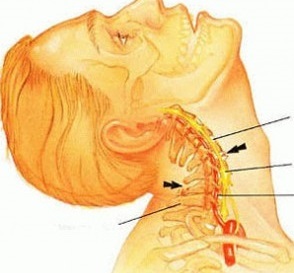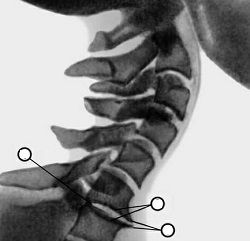Osteochondrosis is a disease of the skeletal system, which is characterized by changes in the cartilage tissue. As a result of the development of the disease, a person's ability to work decreases, blood circulation and the integrity of the intervertebral discs are disturbed. Most of the time, the disease is caused by obesity, physical inactivity, frequent use of the computer or driving a car.
Symptoms of cervical osteochondrosis
Osteochondrosis of the cervical spine as it develops is characterized by the following symptoms:

Neck pain with cervical osteochondrosis
- Continuous headache. The main headache in patients with osteochondrosis is headache, aggravated by a sharp turn of the neck or sudden movement of the head.
- Neck pain that may radiate to the shoulder area. Often appears in the morning, immediately after sleep, decreases or disappears entirely after the neck muscles are warmed up.
- Diaphragmatic lumbago, characterized by sharp neck pain, hardening of the muscles in the affected area and limited mobility.
- pain in the sternum or gallbladder. Most often, patients suspect that they have a pathology of the cardiovascular system, but taking nitroglycerin does not relieve pain. When cervical osteochondrosis is manifested by pain in the sternum, patients complain of a decrease in muscle strength in the arms.
- In almost all patients with osteochondrosis, you can hear a characteristic creak and creak when you ask a person to tilt their head in different directions.
- Hoarseness of the voice.
- Osteochondrosis of the neck can manifest itself as numbness of the tongue and fingertips (a symptom occurs when the nerves and vessels next to the intervertebral discs are compressed.
- Increased blood pressure.
- Paresis of the limbs, decreased muscle strength in the limbs.
The cause of the above symptoms is damage to the connective tissue and the intervertebral discs with their subsequent deformation. As a result of pathological processes, the intervertebral discs become overgrown with bone formations, osteophytes form, which squeeze and damage blood vessels and nerve tracts.
Disease stages
Osteochondrosis of the cervical spine develops in several stages. The further the patient's disease progresses, the more symptoms appear, the more serious the complications of the disease become.
Grade 1 cervical osteochondrosis is characterized by damage to the nucleus pulposus of the intervertebral disc. When the metabolism in the body is disturbed, the nucleus pulposus, a structure of biopolymer compounds, is destroyed. First of all, it loses water, gradually dries up and therefore decreases. Its strength decreases significantly, and it becomes more difficult for the spine to cope with physical activity. At this stage of the disease, a person does not feel pain and does not seek medical help. If you begin to identify osteochondrosis at this stage, the patient will not need drug treatment.
Cervical osteochondrosis of the 2nd degree is characterized by damage to the annulus fibrosus in the intervertebral disc. Due to strong and uneven loading of the spine, cracks and tears appear on the surface of the disc. Due to the fact that the annulus fibrosus becomes thinner, the core is completely pushed out into the resulting cracks and tears, thereby expanding them. As a result, the disc increases in size, begins to step over the edges of the vertebrae. This phenomenon is called disk protrusion. Grade 2 cervical osteochondrosis is the stage of the disease at which a person first feels pain.
Grade 3 cervical osteochondrosis is characterized by the formation of an inguinal hernia. The annulus fibrosus not only thins, but also breaks, so that the nucleus pulposus "flows" into the subglottic space and forms a herniated disc. As a result of the development of the process, all surrounding tissues - ligaments and muscles, nerves and blood vessels suffer.

Over time, the skeletal system of the vertebrae changes: the edges of the vertebrae change their shape, become ribbed and even sharp. The muscles around the changed bone system involuntarily contract, which limits the mobility of the spine. All nerve fibers running through the spinal cord are impaired, the transmission of nerve impulses from the brain to organs and tissues is impaired. It is important that the symptoms of osteochondrosis appear depending on the location of the osteochondrosis.
Grade 4 cervical osteochondrosis is characterized by degenerative reconstruction of the spine. After destructive processes in the body, recovery processes begin to prevail. The fourth stage takes about a year. During this time, the type of bone growth in the deformed vertebra changes. The bone begins to increase in width, which increases the area of the vertebra. Such growths in medicine are called osteophytes. Thanks to them, the mobility of the injured spine is reduced and the processes of its destruction are suspended. Over time, the sedentary vertebra completely becomes a static column of bone.
And when the pain syndrome subsides, the trapped nerves and blood vessels remain in place, they are compressed not only by the intervertebral discs and vertebrae, but also by the osteophytes that have formed. Such processes must be properly treated to prevent the consequences of the disease.
Complications of cervical osteochondrosis
The main consequences of developing cervical osteochondrosis are:
- Vascular diseases (compression of the arteries);
- Formation of hernias of varying severity;
- spinal cord injury;
- osteophyte formation;
- Limited mobility of the spine.
What complications of cervicothoracic osteochondrosis can occur? The most dangerous consequence is the deterioration in the blood supply to the brain. By squeezing the arteries, less blood gets to the brain and the gray matter is poorly supplied with oxygen.
When a patient develops vertebral artery syndrome - when the key blood route to the brain is pinched, the person will experience dizziness and fainting.
In addition to impaired consciousness, patients with osteochondrosis of the cervical spine have visual and hearing disorders. In addition to limb numbness, Dupuytren's syndrome, which is characterized by stiffening of the hands, may develop. With the development of the syndrome, the mobility of the fingers is lost.
Hypertension and vegetative-vascular dystonia (VVD) are common complications. A cosmetic defect that occurs as a result of the development of osteochondrosis is the formation of the withers ("mounds" of cartilage tissue on the back of the head).
Treatment methods
The choice of a method to treat osteochondrosis of the cervical vertebra depends on the stage of the disease. Medical treatment consists of prescribing nonsteroidal drugs, analgesics, and anticonvulsants from a doctor. The dosage of the drug is adjusted at the discretion of the doctor.
Physical therapy is often prescribed to treat osteochondrosis of the cervical vertebrae. With the help of exercises, you can not only get rid of pain, but also reduce inflammation, strengthen your back muscles and reduce the risk of complications.
Massage has a general strengthening effect. After a massage, a patient with osteochondrosis loses tension and pain and the blood supply increases.
When medication doesn't help, doctors need to prescribe surgery. During surgery, doctors remove parts of the intervertebral disc that compress the nerve roots.
The best treatment is a combination of several methods. Medical treatment must be combined with massages, physical therapy exercises and gymnastics.
Some doctors believe that acupuncture and herbal remedies are effective treatments.
Prevention
To relieve pain and prevent the development of osteochondrosis of the cervical spine, you can use simple methods. First of all, every person must be constantly in a position that relieves the spine. It is necessary to remember exercises that knead muscles and support metabolic processes in the spine. To get a positive result, it is necessary to follow the recommendations of the doctor.
Important recommendations:
- Distribute the physical activity evenly over the spine. To do this, limit vertical loads, avoid sudden movements and exercises that can damage the spine. Falls or jumps from great heights should be avoided.
- Do not carry heavy objects by stretching your arms out in front of you. Before you pick up an object from the floor, do not bend forward, but rather crouch.
- Do not move objects with one hand. It is recommended that the load be distributed across both limbs. If this is not possible, consider putting the cargo in a suitcase on wheels or a backpack.
- If you have to carry a heavy load, it is better to put on a wide belt or buy a special corset before work.
- Wear comfortable shoes.
- The best prevention against the disease is swimming, regular exercise and a contrast shower.
- Stressful situations should be avoided.
- You need to remember the rules of a balanced diet.
- Get rid of bad habits.
It is important to understand that preventing a disease is much easier than curing it for a long time and permanently. If surgery is not required in the early stages of the disease, the later stages of osteochondrosis will require surgical intervention.

















































